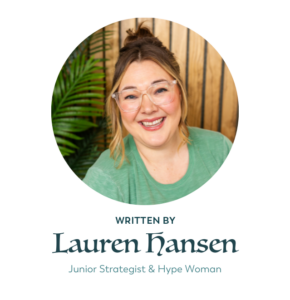So, you’re building a marketing funnel. Sounds easy enough, right? All you need to do is throw up a landing page, collect some emails, and watch the sales roll in.
If only. In reality, creating a funnel that actually converts feels a lot like trying to text with long nails while autocorrect sabotages your every word.

But don’t hit the panic button just yet. We’re here to help!
If you’re a business owner with a to-do list longer than a CVS receipt (which undoubtedly includes “build a marketing funnel” on it), this guide will give you the straight answers you need. No jargon, just 10 actionable steps you can do right now.
Ready? Let’s break it down.
Marketing Funnel Step #1: Know what you’re dealing with
Before we get into the nitty-gritty, we need to talk about why marketing funnels matter.
You can get really specific with funnels (there are lots), but we’ll keep it simple here. We’re JUST focusing on marketing funnels as a whole.
A marketing funnel is how you turn strangers into paying customers without having to stalk them on social media or shout about your product from the rooftops. It’s the process that moves people from “Oh, that’s cool” to “Shut up and take my money!”
Because your customers need a little nurturing before they trust you enough to buy. You wouldn’t propose on a first date, right? (Unless you’re really into rejection.) Think of the funnel as that dating process. You’re wooing your customers step by step.
Without a funnel, you’re just hoping people will buy on impulse. Spoiler alert: most people don’t.
Plus, having a good funnel is good for YOU, too. It takes the guesswork out of sales, automates parts of the process, and helps you scale. Because honestly, you have better things to do than manually follow up with every lead.
Marketing Funnel Step #2: Know what you’re offering
Here’s where the magic really begins. Every good funnel with a great top-of-funnel opt-in that is strategically linked to your bottom-of-funnel offer. If your opt-in or your offer is boring, confusing, or irrelevant, even the most beautiful funnel, with perfectly crafted emails, won’t save you.
Here’s where you ask yourself the tough questions for every offer (free or paid):
- What problem am I solving?
- Who are these people I’m trying to help?
- Why should anyone care? (Harsh, but necessary)
- Does this offer naturally lead to what comes next in my offer ladder?
- This is critical when it comes to freebies. If it’s not providing value AND warming up your recipient to your paid offer, it’s not a strategic opt-in.
Your offer has to be something that your audience can’t resist. Not just something they can tolerate. Whether it’s a free guide, discount, or “exclusive” something or other, it has to be valuable enough that they’ll trade their email address for it.
So…how do your offers stack up?
Marketing Funnel Step #3: Create a landing page that converts
Once you’ve nailed your offer, you need a landing page. This is where people decide whether to give you their precious contact info or run for the hills.
A high-converting landing page is the key to a great first impression. You need it to be clear, concise, and to the point.
You also need:
- A killer headline: Tell them exactly what they’re getting (and be cute or clever if you feel like it).
- Value-driven copy: Explain why your offer will solve their problem or make their life easier.
- Strong visuals: People are visual creatures — so use images or a video to keep them hooked.
- A simple CTA: Make the next step crystal clear. “Sign up now” works. “Please consider exploring the potential benefits of subscribing” does not.
And whatever you do, don’t over-explain. If your landing page reads like a novel, you’ve already lost them. Take it from a content and copywriting team: less is truly more.
Marketing Funnel Step #4: Make them a one-time offer
You’ve already got their attention, so why not suggest another offer they might like? (This is sometimes called a tripwire, FYI.) If you have complimentary products or services that will make using and taking advantage of their new purchase even better, offer it!
If you sell a design product, can you offer a customization upsell?
If you sell a consulting service, can you add additional sessions at a discounted price?
Make your one-time offer (OTO) as much of a no-brainer as possible and make it irresistible by only being available during the checkout process.
Just don’t get greedy — you’re still in the “getting to know each other” phase. No one likes a pushy salesperson.
Marketing Funnel Step #5: Create a confirmation page
A confirmation page, or thank-you page, exists to reassure your audience they’re all set after their purchase/sign-up. A well-crafted thank-you page sets the stage for what happens next. It’s your chance to say, “Thanks, we’ve got more for you.”
Does a confirmation page even matter?
In a word, yes. The confirmation page reassures your lead that they didn’t just toss their email into the void. It’s a small but mighty part of the funnel that solidifies trust.
Here’s what to include:
- A quick thank you (duh).
- A next step: Whether it’s checking their inbox for the offer, following you on social media, or visiting your blog, give them something to do. Don’t leave them hanging.
- A sneak peek at what’s coming next: If you’ve got more content or offers in the pipeline, this is the time to let them know.
Marketing Funnel Step #6: Include a delivery email
Now that they’ve opted in, it’s time to deliver the goods. Your delivery email should arrive fast — people have short attention spans, and you don’t want them to forget who you are. Keep it simple, personal, and focused.
Here’s what to include:
- Thank them again (very demure, very mindful)
- Deliver on your promise: Link to the guide, coupon, or whatever you offered.
- A little teaser for what’s coming next: Get them excited about your upcoming nurture emails.
Oh, and please, make it look human. We know how tempting it is to pass these “easier” emails onto the bots, but people still want to feel like they’re reading emails from actual humans. Use AI to write it, sure, but we’re begging you — don’t pass on polishing it up and making it your own, too.
Marketing Funnel Step #7: Write a killer email nurture sequence
Again, you’re not going to propose on a first date. So why are you going to ask for a sale on one? You need to first build trust, offer value, and show your audience why you’re the perfect fit. And with your email sequence, it’s even MORE important!
Here’s an example of how you can structure it (after the delivery email):
- Email 1: A warm, friendly welcome. Reintroduce yourself, and remind them why they signed up.
- Email 2: Solve a problem. Share helpful tips or a story that makes their life easier.
- Email 3: Social proof. Show them how others have succeeded with your product or service. Tease your next offer(s) if it fits.
- Email 4: Now it’s time for the pitch. Offer them something irresistible — whether it’s a product, service, or consultation.
- Email 5: Provide value. Share an exclusive piece of content, like a private podcast episode or a video tutorial. Connect the messaging between the free content with what they can unlock with your paid offer.
- Email 5: Address common pain points within your audience. Create a sense of community and understanding that you know what they’re facing and provide encouragement. Invite them to solve these problems with your product or service.
- Email 6: Behind-the-scenes look. Give them a peek into your product or service to build connection.
- Email 7: Case study. Deep dive into a success story that showcases the transformative power of your offering.
- Email 8: Special offer. Make them feel special with a limited-time deal.
- Email 9: Hit the full pitch again. What will they miss out on by not purchasing now? What transformation is awaiting them?
- Email 10: Follow-up. For those who didn’t convert, provide additional value and a gentle reminder of your offer.
Space these emails out over a week or two. You want to stay top of mind, but not in a “hey, I’m here again” kind of way.
Marketing Funnel Step #8: Optimize performance
Here’s where a lot of people drop the ball. Once your funnel is live, don’t just set it and forget it. Track your metrics like your business depends on it (because, well, it does).
Here’s what to look out for:
- Conversion rates: How many people are opting in?
- Click-through rates: Are your emails actually being opened and read?
- Engagement levels: Are people clicking on your links? Are they unsubscribing?
- Funnel conversion rate: Of the people that opt-in, how many make a purchase?
Based on the data, tweak and optimize. This isn’t a one-and-done process. Funnels require ongoing fine-tuning to work WELL.
If you’re struggling to convert people to your opt-in, so they’re not even entering your funnel, you need to start there. If your opt-in is converting well but no one is making a purchase, you can focus your efforts on your post-opt-in funnel elements.
Marketing Funnel Step #9: Make updates based on data
No funnel is perfect, and yes, people will drop off. Much like dating in 2024, you’re going to get ghosted at some point.
But not all hope is lost! Here’s where you roll up your sleeves and get creative with:
- Re-engagement emails: Send a friendly reminder or offer something new to get them back.
- Retargeting ads: Use social media or Google ads to remind them what they’re missing.
- Tweak your messaging: If something isn’t working, don’t be afraid to change it. Ask for feedback and use it! Send a post-nurture sequence why-no-buy email to hear from your non-purchasers about what held them back from clicking “add to cart”.
Pro-tip: You don’t have to scrap your whole funnel if you find it’s not converting. Use your data to navigate what pieces need to be tweaked. Adjust. Remeasure. And don’t be afraid to keep tweaking!
The important thing to remember is it’s okay to try, and try again, until you find something that works.
Let’s make your funnel action plan, shall we?
So there you have it — a no-nonsense guide to building a marketing funnel that works.
It’s not rocket science, but it does require some strategy, attention to detail, and a bit of patience. Oh and a lot of copywriting 😓 But if you start with a killer freebie or low-cost offer, nurture your leads with emails that provide real value, and track everything, you’ll have a warmed-up audience ready to buy.
Now, go forth and funnel like a pro!
Not looking forward to doing it on your own? Let the Uncanny team help! We help build high-performing funnels every day. Literally. Let us dig into your offers and your audience with you to create your funnel action plan!

